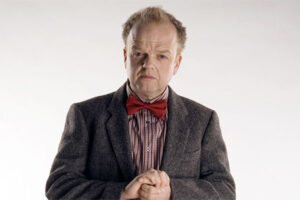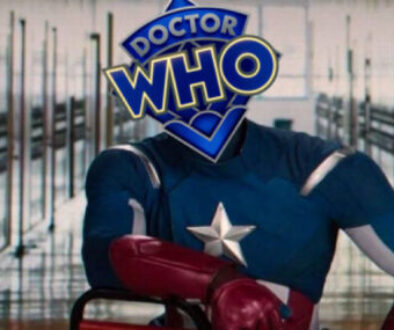What Actually Makes a Story Dark?
Guest contributor Ryan Fleetwood looks at the factors and some recent examples.
So Series 8 is finally moving into sight, we’re on the home straight, and the question on everybody’s lips, whether they want it or not, is: “will Series 8 be dark?” But ask someone what they actually mean by that, and they’re likely to give you a different answer to someone else, and this is where I come in! Let me lead you through the factors that make an identifiably “dark” episode, where we’ve seen them used since the revival, and exactly how effective I feel they are…
Death

This seems to be the most frequently desired element: the demise of a main character, or even just some more background killing. Little explanation is needed for why this creates a darker tone, we see a character we’ve grown to relate to and often experienced the episodes through – and then they’re gone. It creates a sense of peril, a sense of consequence and of course leaves our hearts feeling like they’ve been hit by a porcupine fired from a cannon.
The companion death is the one that is often called for, we haven’t really seen the death of a companion that has stayed permanent since the revival (we saw Amy and Rory’s graves, and we’ve seen Adelaide Brooke kill herself, but the death itself was after a natural life in the first case and actually designating Adelaide a ‘companion’ is a stretch) and so it’s often seen that this would create a new edge to the era. We won’t be waving goodbye to a companion or just leaving them worse off any more, and so no future companion would definitely be safe either.
Deaths of background and more minor characters are also effective. Consider The Waters of Mars, where all but two characters besides the Doctor end up dying, or Turn Left, where the sight of London consumed in a mushroom cloud is, in my opinion, one of the most striking scenes Doctor Who has ever had. There is no doubt that death brings darkness, in particular the more unpleasant deaths, or “near deaths” such as in The God Complex, but it is not a guarantee of a dark episode. Love and Monsters has quite a few deaths in it, whereas both The Empty Child/The Doctor Dances and Silence in the Library/Forest of the Dead end with an “everybody lives” theme. Lots of killing can also desensitise it to the audience, and so it might not be as straight forward a solution as is sometimes suggested.
Fears
 Another aspect of the plot that can create a dark episode is the use of fears. The already mentioned masterpiece that is the Silence in the Library two-parter plays with the common fear of the dark, Midnight uses a claustrophobic setting and the ever memorable The Impossible Astronaut/Day of the Moon plays with that sensation of seeing something out the corner of your eye, and of being watched. This use of common fears has, from what I’ve seen, proven effective whenever it has been used, as it begins to involve the audience. It isn’t just some fictional alien that’s a threat; it’s something that the audience recognises and relates to, it goes beyond just sci-fi.
Another aspect of the plot that can create a dark episode is the use of fears. The already mentioned masterpiece that is the Silence in the Library two-parter plays with the common fear of the dark, Midnight uses a claustrophobic setting and the ever memorable The Impossible Astronaut/Day of the Moon plays with that sensation of seeing something out the corner of your eye, and of being watched. This use of common fears has, from what I’ve seen, proven effective whenever it has been used, as it begins to involve the audience. It isn’t just some fictional alien that’s a threat; it’s something that the audience recognises and relates to, it goes beyond just sci-fi.
Fears can be more than the everyday ones we know well though, Utopia utilises a fear of the end (specifically of the universe) and The Girl Who Waited plays on a fear of being alone, by allowing us to see the results. Fear naturally often combines with death, it’s what creates the peril and what leaves the viewers on the edge of their seats. Compare death by a walking shadow in a spacesuit (accompanied by a skeleton) to death by a big green absorbing monster…
A Relatable Setting
 Similarly to using fears we may recognise and have, a darker tone can also be produced by the setting, and most effectively by using and distorting a setting that we recognise. The list of dark episodes that do this is a long one: The God Complex uses an endless hotel, Amy’s Choice treats us to a creepy rural village full of elderly people and Turn Left goes the whole hog and uses the UK and world as a whole. The aforementioned destruction of London, the British government apparently taken over by a militaristic, authoritarian regime, and refugee camps in cities (“Leeds!? I’m not moving to Leeds!”) all take the world we know and twist it.
Similarly to using fears we may recognise and have, a darker tone can also be produced by the setting, and most effectively by using and distorting a setting that we recognise. The list of dark episodes that do this is a long one: The God Complex uses an endless hotel, Amy’s Choice treats us to a creepy rural village full of elderly people and Turn Left goes the whole hog and uses the UK and world as a whole. The aforementioned destruction of London, the British government apparently taken over by a militaristic, authoritarian regime, and refugee camps in cities (“Leeds!? I’m not moving to Leeds!”) all take the world we know and twist it.
It shows us consequence, it again involves the viewer more and essentially grounds it in the real world. I think this is the most effective means of adding a darker edge. The Power of Three started to take us there, and the juxtaposition between this and the ending I think is one reason why it feels so underwhelming. It can often play off fear (nearly everyone has at some point considered the end of the world in some way, regardless of how much they worry about it or expect it) and will generally involve death as well, and it has led to some of the greatest episodes of the revival.
Perception
 The best example for this is the fantastic Amy’s Choice. A foe who appears and disappears and controls your ability to sleep and dream, playing with the world as the characters see it and knowing their thoughts, the darkness of this episode ultimately stems from the Dream Lord. It’s quite similar to fear, but emphasises the psychological side of things, creating doubt and distortion, real events and events that just look real – an obvious trigger for a dark atmosphere.
The best example for this is the fantastic Amy’s Choice. A foe who appears and disappears and controls your ability to sleep and dream, playing with the world as the characters see it and knowing their thoughts, the darkness of this episode ultimately stems from the Dream Lord. It’s quite similar to fear, but emphasises the psychological side of things, creating doubt and distortion, real events and events that just look real – an obvious trigger for a dark atmosphere.
Silence in the Library/Forest of the Dead uses this with the library’s computer world and Donna’s experiences there, and most of Hide uses it in full horror film style (until the last few minutes… ahem). The scenes in the TARDIS with Amy and Rory in The Doctor’s Wife are, I find, the best of the episode for playing with perceptions and toying with their minds. This is another key reason why death is not always the solution, as deaths (that remain permanent) in these sort of episodes or scenes could be muddled, overshadowed or quite simply jarring.
Changing a Person
 A combination of distorting a recognisable setting and perception, this focuses on the personality and behaviour of the characters involved. The obvious and most common case of this being possession, in many stories throughout the history of Doctor Who, but it can cover less evil changes (the Doctor making himself human in Human Nature/The Family of Blood), more subtle personality alterations and reactions (think of the Doctor’s dark scenes in the middle of the romp that is Dinosaurs on a Spaceship) to some sort of conversion or physical alteration (the headless monks, the Dalek puppets, gas mask zombies, et al.). Seeing a character we know and recognise changed and affected can be the most harrowing of these devices, and is sometimes seen in companion departures (think Donna – if you can without crying). It’s also often presented as an alternative to death under the umbrella term of ‘consequence’ – seeing characters’ lives and personalities left altered and even ruined, and it can have a greater impact than outright dying.
A combination of distorting a recognisable setting and perception, this focuses on the personality and behaviour of the characters involved. The obvious and most common case of this being possession, in many stories throughout the history of Doctor Who, but it can cover less evil changes (the Doctor making himself human in Human Nature/The Family of Blood), more subtle personality alterations and reactions (think of the Doctor’s dark scenes in the middle of the romp that is Dinosaurs on a Spaceship) to some sort of conversion or physical alteration (the headless monks, the Dalek puppets, gas mask zombies, et al.). Seeing a character we know and recognise changed and affected can be the most harrowing of these devices, and is sometimes seen in companion departures (think Donna – if you can without crying). It’s also often presented as an alternative to death under the umbrella term of ‘consequence’ – seeing characters’ lives and personalities left altered and even ruined, and it can have a greater impact than outright dying.
“Into Darkness” – But How Exactly?
Essentially, the factors that create a dark story are more plentiful and diverse than it may at first seem, and the frequent demand for more death seems like it might not be the simple answer to how a darker tone can be established. With many different elements, some that support each other well and others that juxtapose and clash, the underlying outcome is, in my opinion, not the need for just greater consequences, but for the need to make stories that the audience can become immersed in and relate to, with scenarios and characters they recognise being affected.
Nevertheless, while there are demands for the series to adopt a darker tone overall, Doctor Who has – since the revival – had a great deal of success with its darker episodes. We might not know exactly how the Twelfth Doctor will be taking us into darkness yet, but I expect, however it’s done, it will play out excellently.








